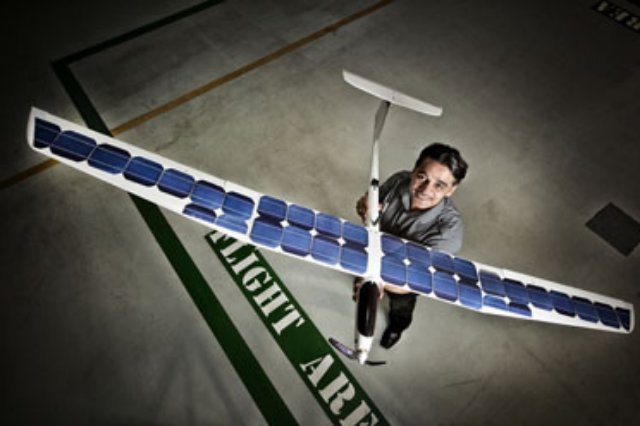Queensland University of Technology Ph.D. student Wesam Al Sabban has designed an unmanned aircraft that would be powered by the sun and wind.
“While all airplanes mimic the shape of birds, the Green Falcon II will literally use the wind to power its movement, just as a bird would,” Al Sabban said.
“As part of my Ph.D. topic we are studying the way birds make use of wind energy to fly with minimum power, the way they glide and use all types of wind to move and change their flight path. We’re developing a UAS with artificial intelligence to forecast solar intensity and use wind patterns for path planning and to power the aircraft. Quite frankly, we expect it to fly like the wind and because it will run on solar and wind power it’ll be cheaper to operate than similar sized UAS on the market.”
A Queensland University of Technology release reports that while a final design is about eighteen months away, Al Sabban was presented with a trio of awards at the recent 63rd iENA International Trade Fair, an inventors’ showcase held each year in Nuremberg, Germany.
He was awarded an independent inventor iENA Gold Medal, a certificate from the International Federation of Inventors Association (IFIA) for outstanding achievement in a world competition for green inventions, and was awarded an honorary Genius Prize from the Association of Hungarian Inventors (MAFE) — the only Genius Prize awarded this year.
At the trade fair, Al Sabban’s invention competed with more than 750 others from thirty countries. Other notable products to come out of previous trade fairs include the skateboard, suitcase on wheels, and a folding bicycle.
“We’re very interested in green technology and for a number of years we have been working on a UAV to mimic the way birds fly so Wesam’s success is a fabulous result,” said his Ph.D. supervisor at QUT Dr. Felipe Gonzalez. Gonzalez, a QUT Aerospace Avionics lecturer based at the Australian Research Centre for Aerospace Automation (ARCAA) said the awards illustrated the world-class research of QUT in artificial intelligence, unmanned systems for civilian applications and aerospace avionics.
“The Green Falcon II will be a zero-emissions UAV capable of round-the-clock service,” he said. “It could potentially assist with powerlines inspection, disaster relief, 3D mine mapping and similar scanning uses. The iENA awards prove there is a market for efficient UAV development and we’ll be looking for partners to turn this unique UAV design into a commercial reality by 2013.”
Al Sabban, a Saudi Arabian engineer, moved to Queensland in 2007 to further his engineering education. He was sponsored by the government of Saudi Arabia as well as ARCAA to present his Green Falcon II at the iENA trade fair.
Source: Press Release


